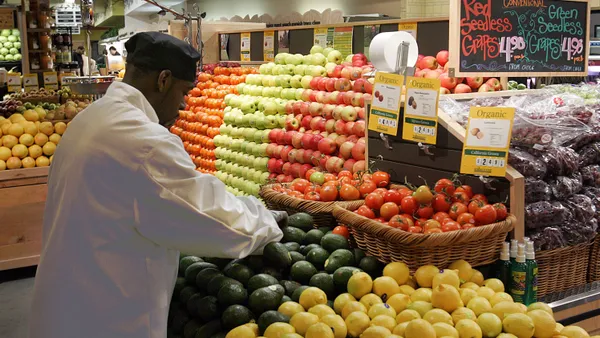Dive Brief:
- Walmart Canada announced it will invest C$3.5 billion ($2.6 billion) over the next five years to update its distribution network, expand e-commerce and upgrade store technology to include more contactless payment options and automated management processes, according to a press release.
-
Using C$1.1 billion, the retailer plans to open a 550,000-square-foot distribution center in Vaughan, Ontario, that will open in 2024, and a 300,000-square-foot facility in Surrey, British Columbia, set to open in 2022. Walmart will also upgrade its existing center in Cornwall, Ontario, with new automated systems designed to help the facility improve its speed and accuracy.
- Walmart Canada will revamp 150 locations — over one-third of its store network in the country — over the next three years. Renovations include adding electronic shelf labels, shelf scanners and computer vision cameras to manage inventory. Stores will also add more touch-free checkout options like tap-and-pay, self-checkout stations and “Check Out With Me" technology, which lets shoppers pay handheld device-toting Walmart workers for their purchases.
Dive Insight:
In order to accelerate its omnichannel offerings to shoppers, Walmart Canada plans to expand pickup to about 270 stores by the end of 2020. It will also introduce "hybrid" locations, which are supercenters with micro fulfillment centers in the backroom that will allow the retailer to increase the speed of its pickup and delivery services.
Investing in its in-store technology and omnichannel experience allows Walmart to serve even more shoppers during the pandemic.
As of Wednesday morning, Canada has had more than 111,000 cases of COVID-19, and about 8,800 people have died from the disease. In March and April, at the peak of coronavirus, when brick-and-mortar stores saw a decline, e-commerce shares set new records and doubled in percentage points in Canada, according to a report by Research and Markets.
If Walmart Canada's online shopping process is faster and more seamless than its competitors', shoppers may be inclined to stick with it even after the pandemic subsides.
But the company is facing challenges from leading Canadian chains like Loblaws and Empire, both of which are folding automation into their e-commerce operations. Sobeys, a chain owned by Empire, recently launched an online delivery service with Ocado serving the Toronto area. The service's automated fulfillment center is located in Vaughan, Ontario — the same city where Walmart will be building its large distribution center.
Walmart Canada also aims to build shopper loyalty through its expanded lineup of checkout options, particularly during the pandemic, since these technologies can reduce interactions between associates and customers.
Walmart is also expanding the self-checkout aisles in the U.S. In June, the retailer began an experiment at a supercenter in Fayetteville, Arkansas, that swaps traditional checkout lanes for self-checkout stations.
According to Stewart Samuel, program director for Canada at retail research firm IGD, Walmart Canada's latest investments borrow from the company's U.S. playbook. In the U.S., Walmart has been testing micro-fulfillment and rolling out new checkout options across its supercenters and Sam's Club stores. Much of the inventory management technology Walmart Canada will be adding to stores has been tested at Walmart's Intelligent Retail Lab in New York.
Samuel noted Walmart has built about as many supercenters as it can in Canada and now needs to turn to innovation to boost shopper engagement.
"Canada is the only major country where Walmart operates from a single physical format, which is almost at saturation point," he wrote in a note published Monday. "However, there is an opportunity to improve the in-store experience, drawing on its latest concepts, accelerate its grocery ecommerce business and drive supply chain efficiencies."









